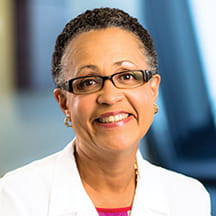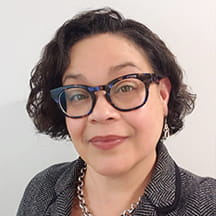Most hospital outcomes are easy to measure: you x-ray a healed bone, you calculate discharge rates, you test blood in a lab. But how do you know whether your entire organization and the care you provide is more equitable and inclusive? Are there tools for measuring? Are there goals that can be quantified? Three children’s hospital leaders, who serve on the Children’s Hospital Association’s Diversity, Equity and Inclusion (DEI) Advisory Group, share ways their organizations measure the effect of DEI initiatives and stay accountable to their mission.
How is your organization measuring the effect of DEI initiatives?
Goepferd: At Children’s Minnesota, measuring and assessing happens in many forms. There are quantitative measures, such as our Health Equity index, that directly measure the clinical initiatives designed to address health disparities and inequitable gaps in care outcomes. There are qualitative outcomes, such as representation in our marketing, media and educational programming, that reflect our values and initiatives in the DEI space. Other quantitative measures include hire, retention and promotion rates of diverse employees, organizational engagement scores relative to DEI initiatives, better capturing of Race, Ethnicity and Language (REaL) data for both employee and patient information, engagement numbers of employees with employment resource groups, and individual impact scores such as Intercultural Development Inventory (IDI) assessments.
Cora-Bramble: The DEI program from Children’s National Hospital is driven by data, which we collect and analyze in at least three different ways: a Diversity Engagement Survey, which provided a baseline assessment to identify strengths and areas for improvement; patient health equity data to ensure equity in the delivery of health care services to all patients; and submissions to our employee bias reporting system, an online confidential system where employees may report incidents where a person exhibits biased words, actions or behaviors. We also plan to measure the effect of a quality improvement initiative centered on patient health equity. Lastly, bias reports are tracked and individually addressed on an ongoing basis.
Negrón-McDaniel: The decades of work we’ve done serve as the foundation of our current Stand Against Racism, Stand for Health Equity framework, which tracks efforts across seven pillars. Our board-approved overarching goal is to embrace the differences and uniqueness of each individual to eliminate racism and ensure optimal health care for all. Across Nationwide Children’s Hospital, quality improvement projects are beginning to stratify data by race, ethnicity, language and/or geography. As our institution strives for health equity, data analyses and visualizations are critical in identifying, understanding and communicating disparities in health outcomes. With this in mind, we created an institution-wide health equity dashboard as a central source of information about population health outcomes and the process outcomes achieved.
How is your organization tracking progress enterprise-wide?
Goepferd: In patient care, Children’s Minnesota has created a health equity dashboard to measure gaps that have great impact on our patient families. In supplier diversity, we have annual goals focused on identifying diverse businesses and creating opportunities for those companies to work with us. For workforce, we have diversity measures woven throughout for greater visibility of outcomes. Some of the data assessed includes turnover, engagement survey results, vacancy rates, FTE to budget, and skills gap assessments. In addition, the HR team assesses the effect of talent management practices on our ability to attract and retain diverse talent, such as annual performance reviews, performance management/disciplinary action outcomes, and talent calibration and succession planning.
Cora-Bramble: We track enterprise-wide DEI progress on several fronts: patient health equity, supplier diversity, minority faculty advancement, quality outcomes and bias reports. Additionally, both the annual employee engagement (separate from the Diversity Engagement Survey) and clinician well-being surveys contain specific DEI questions which we analyze and track. Lastly, we are also tracking the diversity of applicants and participants of our in-house Quality Improvement Leadership Training (QuILT). And as part of our patient safety program, we assess serious safety events and all cause analyses—root cause and apparent cause—for potential bias.
Negrón-McDaniel: The Stand Against Racism, Stand for Health Equity pillars are designed to encompass all intertwined aspects of our organization and shared work; help us identify ways to make antiracism and equity a priority in each of them; and provide lenses we can use to evaluate ourselves and our progress. Our dashboard for these pillars is organized by three types of outcomes: patient-related outcomes, employee/institution-related outcomes and community outcomes. Our goals in each area are tracked quarterly and visually represented on the hospital’s intranet for all staff to see.
What measures matter most?
Goepferd: The feedback we get back from patient families on their care journey with us and from our employees on their work experience are critical to informing our decisions and ensuring we are taking the necessary steps to stay true to Children’s Minnesota’s vision of being every family’s essential partner in raising healthier kids. We want Children’s Minnesota to be a place where all families know and trust their kids will get the best possible care. We want to be an employer of choice for diverse talent who know they are valued and belong as a part of the Children’s Minnesota family.
Cora-Bramble: At Children’s National, we strive to foster, nurture and sustain a culture where everyone feels welcomed, valued and respected. For our patients, this means providing excellence in care to all in a nurturing and healing environment. For our staff, it means maintaining a just and inclusive work environment that promotes a sense of belonging. And for the community we serve, it means offering our unwavering commitment to their health and well-being.
Negrón-McDaniel: Health equity and achieving the best outcomes for children of all backgrounds and identities regardless of ability to pay has always been central to the mission of Nationwide Children’s Hospital. Our actions today are on a broader scale, but the needs of families we serve are the same. We will always continue to better ourselves to provide the best possible environment for our employees and best possible care for our patients and their families. This is what we do and who we are—it always has been and always will be.
Connect and share information with your peers in CHA’s online Diversity, Equity and Inclusion community.





